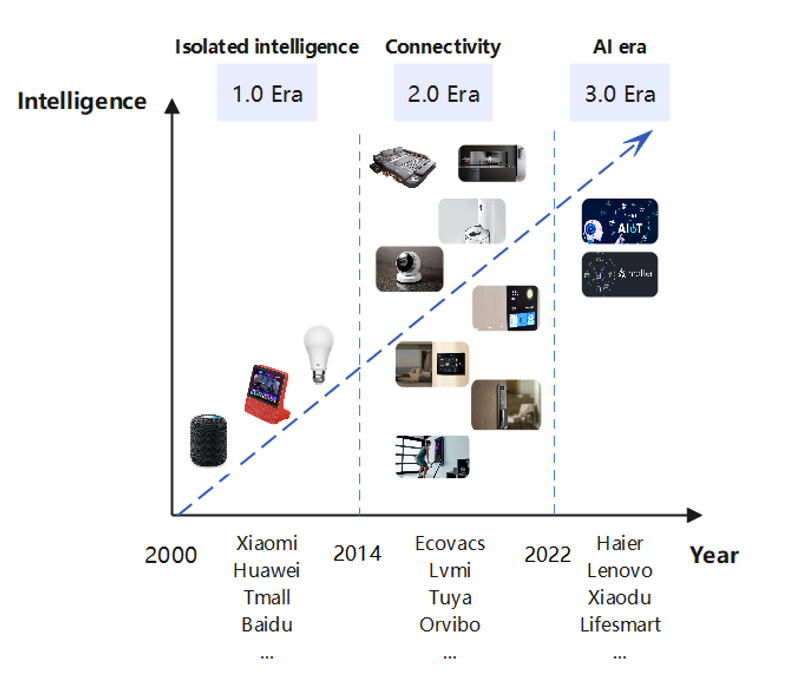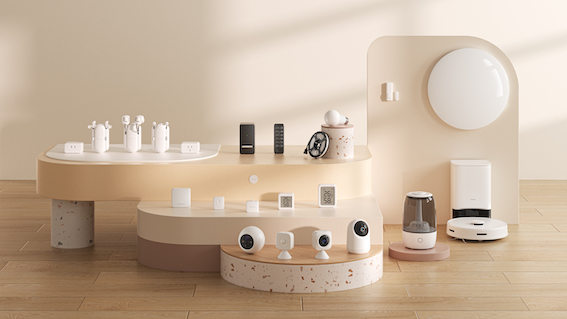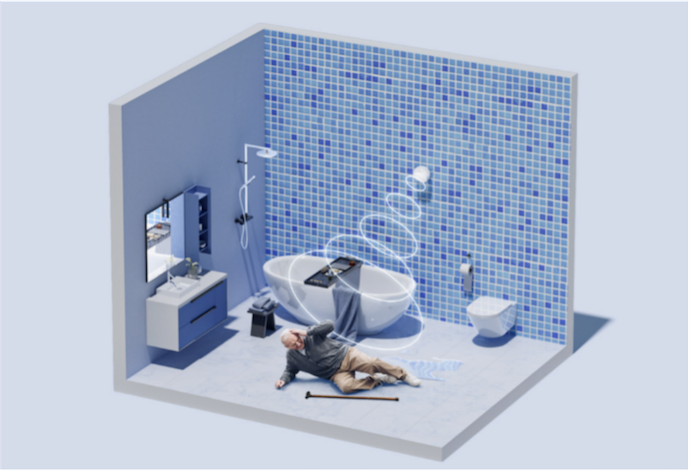Ventech China Insight |The New Future of Smart Home
In recent years, smart home products have been rapidly developing and iterating. By 2022, the smart home market has expanded to an impressive size of RMB 650 billion. At the same time, each product category has also fostered its own "Champions(Leading companies)".
Now, people are wondering whether the smart home market is entering into another competitive stage like the traditional home appliance market.
Following the past and looking forward to the future:
The Evolution of Smart Home
One may often hear the question, " I don't feel like the smart devices at my home are that smart right now. They just add a new function - Phone Control." To address this common skepticism, let us look at the evolution stages of smart home devices.
Broadly, the progression of smart homes can be segmented into three eras: the 1.0 era (Isolated intelligence), the 2.0 era (Connectivity), and the emerging 3.0 era (AI integration).

At this juncture, the majority of smart home categories are transitioning from the latter half of the 2.0 era. While the 1.0 era aimed to maximize the intelligence of individual devices, the 2.0 era emphasized the connectivity of multiple devices across various scenes. Devices could be controlled through multiple interfaces like apps and voice commands, turning the smart home into an ecosystem integrating multiple product categories and functions.
Marked by the emergence of GPT at the end of 2022, the AI models have entered a new cycle of iterations. As the Transformer-based AI models become mature and further explored, smart home devices will gradually enter the 3.0 era.
The integration of AI will revolutionize user interactions with smart home devices, significantly enhancing the devices' abilities to understand user needs proactively and elevating the level of intelligence. The involvement of advanced AI models can also stimulate the development of new smart home categories, transforming previously unattainable possibilities into reality.
We can boldly imagine how AI-integrated smart home devices will serve users. However, before we enter the "Magic world", we need to first discuss the scenarios that current smart home products serve and the consumer motivations behind them, getting a clear picture of the future of smart home devices.
The Diverse Application Scenarios of Smart Homes
Focusing on the product's core strength, manufacturers have consistently strived for improved speed, efficiency, and conservation.
The goal is to connect more devices (Greater), reduce latency (Faster), ensure stronger reliability (Better), and conserve power and bandwidth (Economical).
However, it begs the question: Do manufacturers' objectives align with consumers' needs? What kind of products are consumers really looking for?
For smart homes, consumer demand can be distilled into three core needs: "Comprehensive security," "Personalized care," and "Convenient assistant."
"Comprehensive security" denotes intelligent protection, an integral part of everyday life and a significant focus for smart homes products. A well-rounded security program can make accurate judgments through intelligent perception and initiate active defense measures. It will be able to warn and alert residents through various means before danger occurs, and quickly coordinate with community property management and other smart home devices in real time to handle dangerous situations.
Switchbot, a Ventech China's portfolio, its Smart Lock, designed and developed for the Japanese market, gained immense popularity and ranked first in the 2022 Japanese "Home Appliance Rank" for smart locks. Furthermore, the SwitchBot app has become the leading smart home application in Japan, and its products are selling well in over 70 countries. To achieve the ultimate goal of comprehensive security, it's imperative that devices provide "faster, better, connected’, linking more devices through a robust system to ensure no blind spots within the home.

Source: Product portfolio of SwitchBot
"Personalized care" like "comprehensive security", is another key aspect, especially concerning home-based seniors, children, and pets. Smart home devices, equipped with machine vision and corresponding AI algorithms, can identify any abnormal conditions among family members and notify others, providing real-time care and personalized services.
With the rapid onset of an aging population in China, home-based elderly care will gradually become mainstream, and the need for smart homes suitable for the elderly will also increase day by day. In the near future, elder-friendly functions will also become an important driving force for the continued growth of the smart home market.

Source: EZVIZ
The "Convenient Assistant" epitomizes the smart home 2.0 era. Its primary purpose is to simplify home management tasks and enhance the user's quality of life. Leveraging the Internet protocol from the 2.0 era, diverse smart home devices can be managed and controlled through a unified platform, catering to various usage scenarios. This platform could be a smartphone, a centralized intelligent control screen, or an AI natural language processing platform. Presently, most intelligent hardware companies are working diligently to craft their own ecosystem of use-cases, leading to the development of numerous subcategories like smart entertainment, smart appliances, smart lighting, and so forth. After years of price war and inventory competition, brands and manufactures are expected to develop such a new AI butler to capture new market shares.
Having understood the three major consumer motivations for smart home devices, the next question that comes to our mind is: What kinds of functions are brands and manufacturers developing, and how are they developing them? What is the fundamental mindset around expanding product categories - will there be new major categories emerging in the future?
The Expansion of the Emerging Smart Home Category
Over the past five years, alongside the continuous evolution of raw materials and communication protocols, we have observed the proliferation and rapid iteration of various categories and scenarios such as smart audio, smart locks, intelligent lighting, and intelligent robots. Currently, there are more than 30 smart home devices’ categories, essentially encompassing all home scenarios. Although the development of the protocol and interaction layers within smart home devices still needs time, the idea of comprehensive smart home solution is no longer a distant dream. At the 2023 AWS Exhibition, major companies like Haier, Lvmi, and Huawei all presented relatively complete solutions for whole-house intelligence.
However, currently, most efforts primarily focus on specific home environments like bedrooms, living rooms, and bathrooms, resulting in relatively limited coverage. Category expansion, though, is ongoing.
Therefore, the overall category expansion of smart homes will follow two primary development paths.
The first one involves scenario expansion. For instance, UFOU, a home brand under Ventech China's portfolio, is expanding into the study room scenario. By innovatively transforming the desk, it enables a shift from intelligent 1.0 to intelligent 2.0, filling the gap in the smart home market for study spaces.

Source: UFOU Lift Desk
In the future, smart homes will further explore more specialized scenes, such as game rooms, office spaces, and other public areas.
Another approach is upgrading individual products. The existing products that will enter their own 3.0 era, significantly improving their level of intelligence. As one of the three fundamental pillars of the 3.0 era, AI foundation models saw a monumental moment at the end of 2022. The way users interact with smart home devices will undergo significant iterative innovations, ushering in an era of proactive understanding.
The Future of Smart Homes
As smart homes have evolved from the 1.0 era (Isolated intelligence) to the 2.0 era (Connectivity), and now marching towards the 3.0 era (AI era), their coverage and functionality have continually expanded, becoming an indispensable assistant to users.
Currently, Alibaba has announced that a series of smart home devices like Tmall Genie will integrate its self-developed foundation model " Tongyi Qianwen." Likewise, home appliance giants like Midea, Changhong, TCL, and Hisense have announced plans to integrate Baidu's foundation model "Wenxin Yiyi." These foundation models will inevitably expedite the pace of the smart home manufacturers' "Arms race." The research and development of the next generation of smart home products will continually focus on two core issues: How to better integrate AI models into the original ecosystem, and How to develop new features based on new technologies to further optimize the user experience.
A new wave of smart home is coming, what means "smart device" for you? What kind product you want? Welcome to leave your message.
